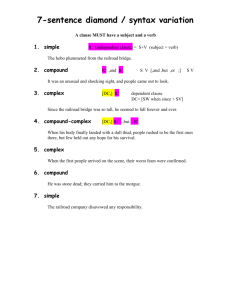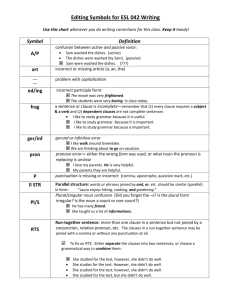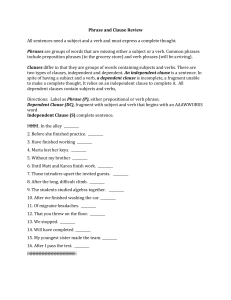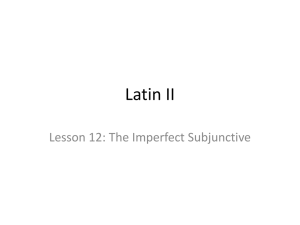The Subjunctive
advertisement
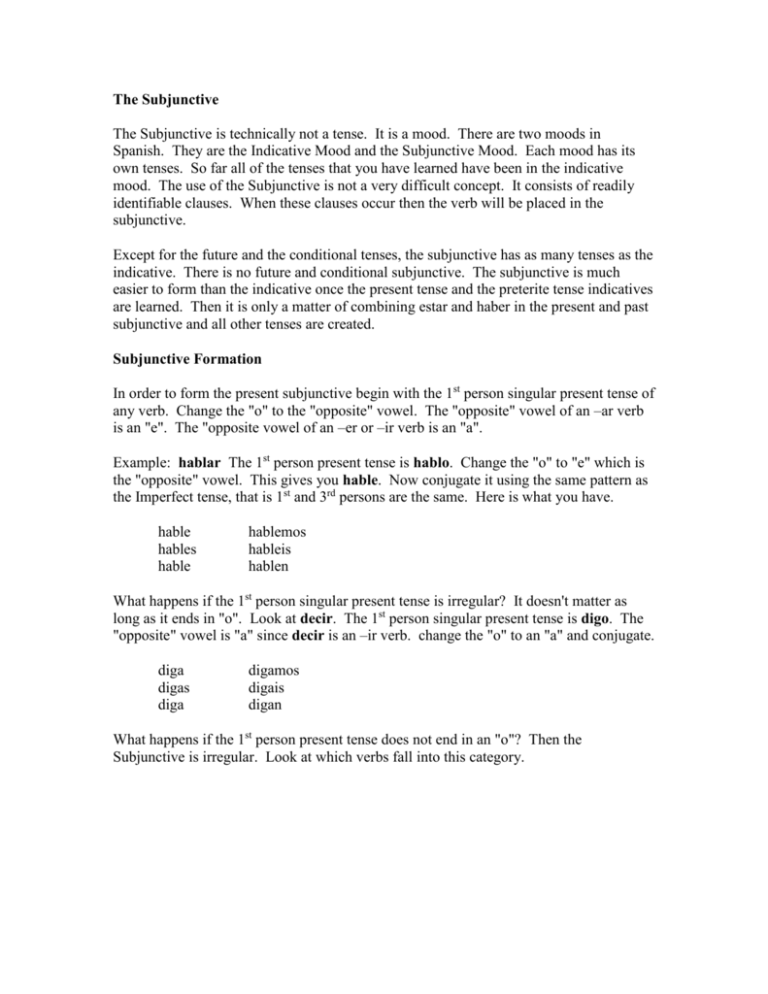
The Subjunctive The Subjunctive is technically not a tense. It is a mood. There are two moods in Spanish. They are the Indicative Mood and the Subjunctive Mood. Each mood has its own tenses. So far all of the tenses that you have learned have been in the indicative mood. The use of the Subjunctive is not a very difficult concept. It consists of readily identifiable clauses. When these clauses occur then the verb will be placed in the subjunctive. Except for the future and the conditional tenses, the subjunctive has as many tenses as the indicative. There is no future and conditional subjunctive. The subjunctive is much easier to form than the indicative once the present tense and the preterite tense indicatives are learned. Then it is only a matter of combining estar and haber in the present and past subjunctive and all other tenses are created. Subjunctive Formation In order to form the present subjunctive begin with the 1st person singular present tense of any verb. Change the "o" to the "opposite" vowel. The "opposite" vowel of an –ar verb is an "e". The "opposite vowel of an –er or –ir verb is an "a". Example: hablar The 1st person present tense is hablo. Change the "o" to "e" which is the "opposite" vowel. This gives you hable. Now conjugate it using the same pattern as the Imperfect tense, that is 1st and 3rd persons are the same. Here is what you have. hable hables hable hablemos hableis hablen What happens if the 1st person singular present tense is irregular? It doesn't matter as long as it ends in "o". Look at decir. The 1st person singular present tense is digo. The "opposite" vowel is "a" since decir is an –ir verb. change the "o" to an "a" and conjugate. diga digas diga digamos digais digan What happens if the 1st person present tense does not end in an "o"? Then the Subjunctive is irregular. Look at which verbs fall into this category. Infinitive ser estar ir dar saber haber 1st Person Present Tense soy estoy voy doy sé he Subjunctive sea esté vaya dé sepa haya As you can see there aren't that many that do not end in "o" in the 1st person singular present tense. Even though there are a lot of irregular 1st person verbs they technically are not irregular in the Subjunctive. Subjunctive in Noun Clauses To understand noun clauses it is necessary to define a clause. A clause is a part of a sentence that contains a conjugated verb as opposed to a phrase that does not contain a conjugated verb. Every complete sentence must have at least one independent clause. If the clause can stand alone then it is called an independent clause. This means that you can put a period at the end of the clause, and it can stand as a complete sentence. If the clause cannot stand by itself, it is called a dependent clause. This is because it depends on the independent clause to form a complete sentence. I know the boy that lives next door. I know the boy is the independent clause. that lives next door is the dependent clause. He went to the store and he bought some milk. He went to the store is independent and he bought some milk is also independent. This sentence has two independent clauses. In Spanish a sentence that contains more than one clause must connect them with a conjunction. Words such as y, o, or pero (and, or, but) generally connect independent clauses and que, cuando, donde (that, when, where) generally connect independent with dependent clauses. When a dependent clause is the direct object of the verb of the independent clause it is known as a Noun Clause. This is because only nouns and pronouns can be direct objects. Look at the following sentence. I want you to go. What I want is "you to go". Therefore "you to go" is the direct object of the verb to want. But we have a problem in Spanish. An infinitive cannot have a subject in Spanish. Therefore we have to turn the "you to go" into a real clause and connect it to the independent clause with a conjunction. The conjunction in Spanish that we will use is que. Therefore the sentence will become: I want that you go. "that you go" is now a real clause with a conjugated verb. And here is your first rule for the subjunctive. The verb in the dependent noun clause is conjugated in the subjunctive when there is a change of subject from the independent clause. Yo quiero que tú vayas. Let's put it in simpler less technical language so that you can get the feel of what it sounds like in English and Spanish. Here is an easier rule: When you want ask demand prefer require tell someone else to do something it requires the subjunctive in the 2nd conjugated verb. Quiero que vayas. Pido que vayas. Mando que vayas. Prefiero que vayas. Requiero que vayas. Digo que vayas. I want you to go. I'm asking you to go. I demand you go. I prefer you to go. I require you to go. I'm telling you to go. What is key here is that the subject of the dependent clause (the one going) must be differenent than the subject of the independent clause (the one wanting, asking, ordering etc.). Look at the difference in these sentences. Quiere ir. Quiere que vaya. He want to go. He wants me to go. Notice the change of subject. In the first the one wanting and the one going are the same person. Therefore it is simply followed by an infinitive. But when the subject of the first verb wants another to do something, then the 2nd verb is placed in a subjunctive clause.


